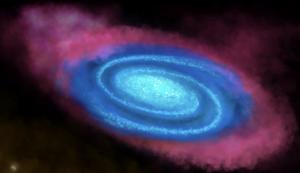Project area/S
- The Local Universe / The Distant Universe
Project Details
It is now well established that star-forming galaxies follow a well-defined relation in the star formation rate (SFR) vs. stellar mass plane, referred to as star-forming main sequence (SFMS). Recent studies have shown that, while this relation is linear from dwarfs to Milky Way-size galaxies, at higher stellar masses it bends towards lower SFRs. Moreover, the scatter of this relation (i.e., intrinsic variation in the SFR of galaxies at fixed mass) is not constant. The physical reasons behind these changes in shape and scatter are still debated and proposed scenarios range from environmental effects, feedback or morphological transformation. Surprisingly, most previous work has focused on the optical properties of galaxies on the main sequence and little is known about their gas content, star formation efficiencies and how they can contribute in shaping how galaxies move in the stellar mass vs. SFR plane.
In this project, the student will have the possibility to address one or more of these issues by combining, for the first time, gas information for large statistical samples of nearby galaxies. The project will be focused on the reduction and analysis of brand new data obtained as by the Atacama Large Millimeter Array for a sample of a few 100’s galaxies to quantify the role of molecular hydrogen in setting the shape of the star-forming main sequence.
Student Attributes
Academic Background
Basic knowledge of astronomy.
Computing Skills
Basic python knowledge (e.g., ability to read and write files and to make basic plots).
Training Requirement
Ability to handle astronomical data and to understand basics of astronomy observational techniques
Project Timeline
- Week 1 Inductions and project introduction
- Week 2 Initial Presentation
- Week 3 Data Reduction
- Week 4 Extraction of key physical information such as fluxes and velocity widths
- Week 5 Characterization of seeing and potential variations across field of view in r-filter
- Week 6 Combination of ALMA data with multiwavelength datasets already available
- Week 7-8 Scientific analysis of the data
- Week 9 Final Presentation
- Week 10 Final Report

HI gas (magenta) around the stars & cold gas (blue) in a galaxy

